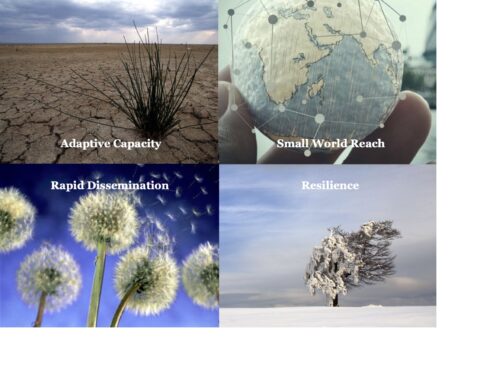Network Weaving for Equitable Wellbeing (Part 1)
November 29, 2022 2 CommentsThe following post was written for those who will be attending the Full Frame Initiative’s (FFI) Wellbeing Summit in Charlotte, North Carolina December 11-14. The Interaction Institute for Social Change has been supporting FFI staff and signers of the Wellbeing Blueprint in developing network ways of thinking and doing as they work to equitable wellbeing in systems ranging from health care to transportation to housing to education to legal aid to food and beyond. Feel free to sign the Wellbeing Blueprint by going to the link above and join the movement to ensure that everyone has a fair shot at wellbeing.
“It really boils down to this: all life is interrelated. We are all caught in an inescapable network of mutuality, tied into a single garment of destiny. Whatever affects one directly, affects all indirectly.”
– Rev. Dr. Martin Luther King Jr. (minister, activist, civil rights leader)
What are networks, and why should we care?
Networks are collections of “nodes and links,” different elements that are connected to each other. These nodes or elements could be people, places, computer or airport terminals, species in an ecosystem, etc. Together, through their connections, these nodes create something that they could not create on their own. This is what some might call “collective impact” or what network scientists call “net gains” and “network effects.”
“While a network, like a group, is a collection of people, it includes something more: a specific set of connections between people in the group. These ties are often more important than the individual people themselves. They allow groups to do things that a disconnected collection of individuals cannot.”
– Nicholas A. Christakis (sociologist, physician, researcher)
Network effects and net gains can include the following (see image below):
- Resilience – The ability for a network to weather storms of different kinds, literal and metaphorical, and to bounce back from adversity. Healthy networks can bend without breaking.
- Adaptation – The ability for a collective to change with changing conditions. Healthy networks can rearrange themselves to adjust and respond to disruptions and perturbations.
- Small World Reach – The ability to reach others relatively quickly, across different lines of separation or difference (geography, culture, sector, etc.) . Healthy networks have a diversity and intricacy of pathways, so there are a variety of ways to reach many different nodes/members efficiently.
- Rapid Dissemination – Related to reach, this is about the ability to get crucial resources out to a wide variety of nodes in a timely manner. Healthy networks can ensure that different members can get the nourishment (information, ideas, money, food, etc.) they need to survive and thrive.
“Connections create value. The social era will reward those organizations that realize they don’t create value all by themselves. If the industrial era was about building things, the social era is about connecting things, people, ideas.”
-Nilofer Merchant (entrepreneur, business strategist, author)
Other “network benefits” can accrue to individual nodes or members of a network. For example, when surveying members of different kinds of social change and learning networks, some of what often gets mentioned as benefits include:
- Being with other people who inspire and support me
- Learning about topics relevant to my work
- Understanding the bigger picture that shapes and influences my work
- Gaining new tools, skills and tactics to support my work
- Having my voice and efforts amplified
- Accessing new funding and other resources
- Forming new partnerships and joint ventures
What is a healthy network?
“We are the living conduit to all life. When we contemplate the vastness of the interwoven network that we are tied to, our individual threads of life seem far less fragile.”
– Sherri Mitchell/Weh’na Ha’mu’ Kwasset (Penobscot lawyer, activist, author)
A healthy network is one that is able to achieve its collective purpose/core functions, while also addressing the interests of its members, and continuing to be adaptive to changing circumstances. Some key features of these kinds of networks include:
- Diversity of membership
- Intricacy of connections (many pathways between nodes)
- Common sense of purpose or mutuality; a sense of a “bigger we”
- Robustness of flows of a variety of resources to all parts of the network
- Shared responsibility for tending to the health and activity of the network
- Resilient and distributed structure(s) with a variety of shared stewardship roles
- A sense of equitable belonging and ability to give to/benefit from the network
- Ongoing learning and adaptative capacity
Like any kind of living organism, networks require care and feeding to keep them vibrant. This is where network weaving comes into play! More on this in the post to follow on Thursday, December 1st …



2 Comments
Creating networks is fundamental, and for “species in an ecosystem” also. That is, it is as important to recognize and foster networks in species that are other-than-human and, critically, between humans and such species. This is an essential aspect of inclusivity that seems underemphasized.
Agreed, David. And we want make sure that people support this in the human realm. We have seen instances where people justify “equity of nature” at the expense of “social justice.” Of course we are all, nature. Love ALL our kin. People can be funny about this.